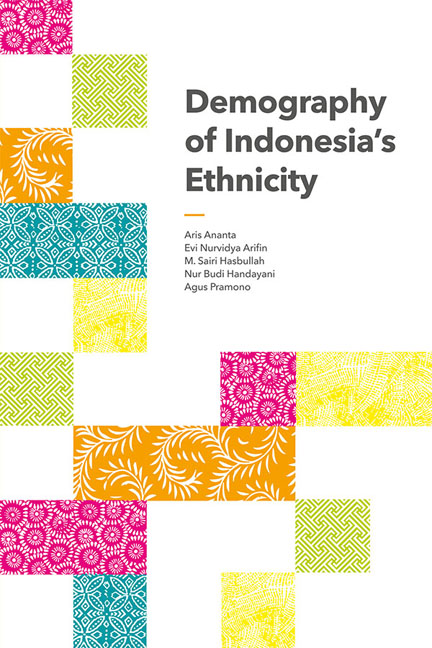Book contents
- Frontmatter
- Contents
- List of Tables
- List of Figures
- Foreword
- Acknowledgements
- 1 CHANGING INDONESIA: An Introduction
- 2 COMPLEXITY OF STATISTICS ON ETHNICITY: Concept, Data and Method of Analysis
- 3 THE NEW CLASSIFICATION: Uncovering Diversity
- 4 ETHNIC DIVERSITY: New Demographic Evidence
- 5 THE FIFTEEN LARGEST ETHNIC GROUPS: Age-Sex Structure and Geographical Distribution
- 6 CHANGE IN SIZE AND COMPOSITION OF ETHNIC GROUPS: Indonesia, 2000–2010
- 7 RELIGION AND LANGUAGE: Two Important Ethnic Markers
- References
- Appendix 1
- Appendix 2
- Index
- About the Authors
4 - ETHNIC DIVERSITY: New Demographic Evidence
Published online by Cambridge University Press: 10 October 2017
- Frontmatter
- Contents
- List of Tables
- List of Figures
- Foreword
- Acknowledgements
- 1 CHANGING INDONESIA: An Introduction
- 2 COMPLEXITY OF STATISTICS ON ETHNICITY: Concept, Data and Method of Analysis
- 3 THE NEW CLASSIFICATION: Uncovering Diversity
- 4 ETHNIC DIVERSITY: New Demographic Evidence
- 5 THE FIFTEEN LARGEST ETHNIC GROUPS: Age-Sex Structure and Geographical Distribution
- 6 CHANGE IN SIZE AND COMPOSITION OF ETHNIC GROUPS: Indonesia, 2000–2010
- 7 RELIGION AND LANGUAGE: Two Important Ethnic Markers
- References
- Appendix 1
- Appendix 2
- Index
- About the Authors
Summary
This chapter uncovers new demographic evidence of ethnic diversity in Indonesia. As listed in Chapter 3, the 2010 population census recorded a very large number of ethnic categories and we reclassified them into a New Classification of ethnic groups. With this classification, this chapter presents and discusses the ethnic composition in Indonesia as a whole and within each province. First, it examines the ethnic composition at the national level by limiting itself to the fifteen largest ethnic groups in Indonesia. These fifteen ethnic groups already formed a very large portion of the total citizens in Indonesia, accounting for 84.9 per cent in 2010.
Second, it analyses the ethnic diversity in each of the 33 provinces. This discussion at the provincial level better shows Indonesia's ethnic diversity. It details various degrees of heterogeneity amongst provinces. It then provides an expanded list of ethnic groups to capture a more comprehensive view of Indonesia's ethnic spread as a whole, by combining all large ethnic groups within the provinces. Finally, this chapter reveals the degree of “ubiquity” of the ethnic groups amongst the various provinces in Indonesia.
Amongst other things, this chapter also discusses local ethnic groups versus migrant ethnic groups in each province to provide a glimpse into migration phenomena. Local ethnic groups are defined as the people who originate in a province although nowadays they may live in many other provinces in Indonesia or overseas. On the other hand, migrant ethnic groups are defined as those who did not identify themselves as one of the local ethnic groups in the provinces where they live. They may just have arrived in Province A some years earlier, they may not have been born in this province, but it is also possible that they were born in Province A and have been in Province A for many generations. As long as they identify themselves with an ethnic group originating from outside Province A, these respondents are called migrant ethnic groups.
Furthermore, although the number and percentage of foreigners are still small, the presence of foreigners is likely to increase and hence play an important role in future interaction with the people of Indonesia (Ananta and Arifin 2014). Therefore, this chapter discusses the demography of the foreigners before elaborating on the ethnic composition in each province. This is the first detailed demographic study on foreigners in Indonesia, another first for this book.
- Type
- Chapter
- Information
- Demography of Indonesia's Ethnicity , pp. 68 - 130Publisher: ISEAS–Yusof Ishak InstitutePrint publication year: 2014



